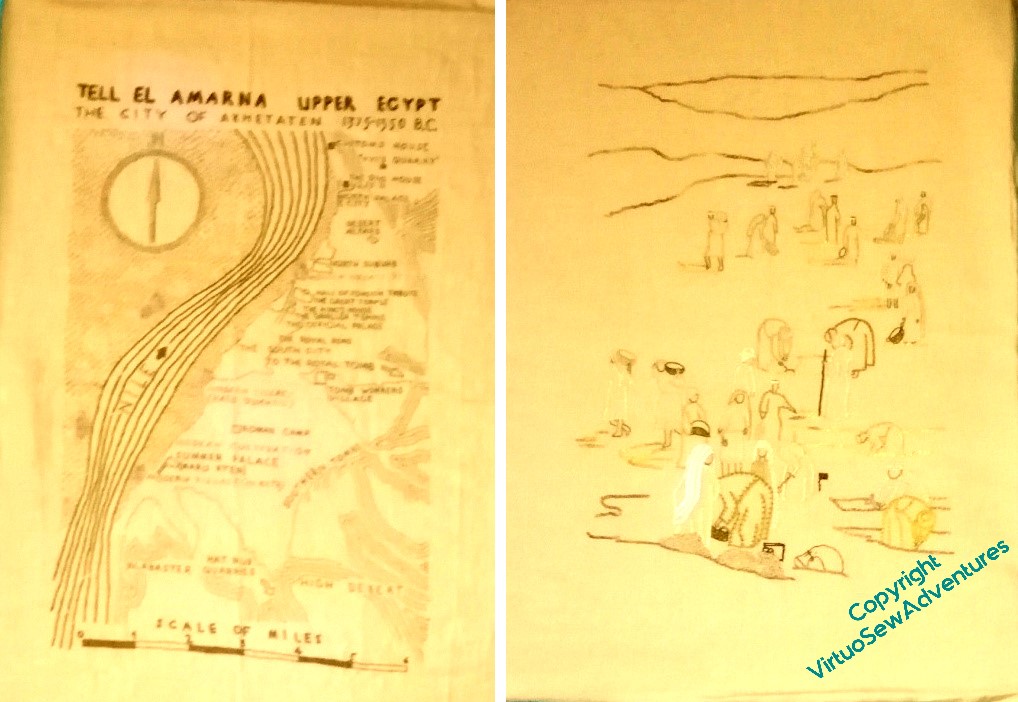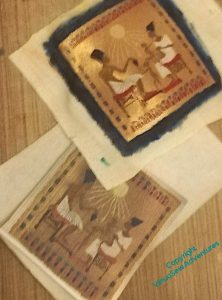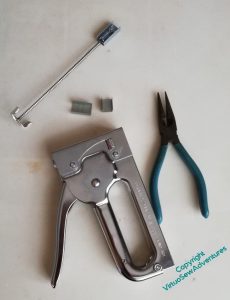Category: Large Embroidery Projects
Beginning the additions to the Excavation
There will be a lot to do, I think, to bring the Excavation up to balance the Map properly. In my usual fashion, I will sneak up on this, doing what seems obvious and then waiting to see what seems necessary.
The first thing that was obvious was that something should be done to point up the idea of the trenches being dug. Row upon row of vertical running stitches seemed to me to suggest the walls of a trench – maybe not accurately, since the book suggests more of an open area excavation. The photographs I used as my source for this, however, suggested that there were at least a few individual trenches.
The next obvious element was a dust cloud to suggest activity stretching into the distance. Tiny random seed stitches in two or three shades of stranded silk were, again, the obvious choice, although I do wonder, now, whether those will be sufficiently emphatic when I set the panels side by side again.
As I believe I’ve already mentioned – random stitching is really quite difficult to achieve!
At this point I decided it needed much more “weight” at the bottom of the image, and chose to use tête de boeuf stitch (upside down to resemble a plant) as I did originally on the Map to suggest the cultivation on the far side of the river. These tête de boeuf stitches are much bigger than the ones on the map, using two strands of the variegated silk thread, and I’m going to spread them right across the breadth of the panel towards the bottom.
More thoughts on display
Two elements that sprang into mind very early in my work on the Amarna panels were the Clump of Violets and the bead necklace. The violets are to call to mind Mary’s exasperating experience, familiar to any language learner, of having useful vocabulary and structure retained only with the greatest of efforts, while the entirely useless just sticks – in her case, the Arabic for “violets” stuck in her head with no difficulty, whereas the words for “bread”, “bath”, or “dig” proved recalcitrant. The bead necklace is my reinterpretation of one of hers, owned in childhood and subsequently lost, like the necklaces she helped to excavate.
These two pieces link directly to Mary, and not to Egypt itself, and because of that, and because of their colour, they don’t sit well with the main panels, and I was left somewhat perplexed about them. Until something brought parlour domes to my mind, and the lights went on!
I thought that maybe if I used the clump of violets to top a golden trinket box, and allowed the necklace to spill out, the two pieces might live together happily as my representation of Mary herself. I found a small round cardboard trinket box and sprayed it gold (a very pale, insipid gold, it turned out, too, not at all what I wanted!), and began to experiment.
I think the whole thing needs to sit on a cushion within the dome, and the trinket box should be between the tall experiment and the short one in height, and a little narrower to allow the leaves to droop over the edge.
So while I work on achieving that, I have put away both violets and beads, and replaced them in the dome with the Glittering Nightcap.
Which is so happy that it is refusing to give it back, and I will have to buy another parlour dome for Mary’s trinket box!
More work needed…
If you compare these two layouts, you may notice a bit of a difference.


When I pulled out the panels to give the measurements to my friendly carpenter, I reduced all the dimensions slightly to concentrate the whole assembly. I’ve noticed recently that whereas watercolours are the better for being mounted with plenty of “air” around them, embroidery is often the better for being framed quite closely. This will help me to achieve that.

When I have the coloured fabric mounted, I will be able to continue planning the placement of the spot designs. And in the meantime . . . I’ve had to pull out the colour and contrast above here, to try to show what is worrying me here. These two panels are supposed to balance each other, and I don’t think they do, or at least, not yet. I think I need to do a bit more stitching on The Excavation so it can stand up to the Map of Amarna.
I’ve started in the far distance with some seed stitching. It’s going to take some time to get the right level of texture in the right places, but it’s always good to have made a start!
When in doubt, delegate!
You may recall that I was beginning to think about assembling the Amarna panels, and suffering from Alarms, because I wasn’t sure how to make suitable mounts.
I was beginning to think about finding a timber merchant (our local one has closed) when a carpenter and his apprentice came to do some (very necessary) work on our windows. It didn’t take long to realise that they are both fine craftsmen, and it occurred to me that the intelligent choice was to ask whether, during the couple of days when they worked on things in the workshop, they could also make me some mounting frames for my embroidery.
Not only could they do so, but they made a beautiful job of them, as you can see from this test layout of one set of the panels. The wood has been sanded smooth so as not to snag either the cloth or the embroiderer, and there is some bracing to keep everything square and true. It seems a crime to cover them…
In fact, I was so thrilled with them, that I promptly asked for mounting frames for Akhenaten and Nefertiti as well!
Once I had them all, I decided the first thing to do was to cover each with a layer of calico to support the padding.
My word, that was a task. I’m very pleased with the results, but before I start covering them with the padding, and the real fabric, I need to have a break from the staple gun. It has a kick like a Victorian army mule, and very nearly as bad a temper!
Thinking about assembly for “Dreams of Amarna”
It is all very well having a whole host of little embroideries and a general intention to use them to embellish a larger piece, but that begs a whole series of questions about assembling those larger pieces. I’ve left the embroideries untrimmed and unfinished, which will make them hard to manage while I experiment, so the first thing to do was to photocopy the “spot” embroideries and cut them out.


I’ve got mount card in the sizes of the blocks covered with the linen I intend to use, which made it possible to lay out the panels on the floor, stand back, and stare.


One decision I’ve made is that I don’t want the cartouche and the hippo (on the same fabric) either on the same panel or on the level as they are in this second example. I’m trying to put elements related to Mary’s first experiences around the map, and other elements around the dig scene – not quite achieved yet, I think.
My main take-away from this first exploration, however, is that I’ve made the pieces too wide. Since the two Crests are somewhat inflexible, I may find myself having to do them again, or think of something else.
Nothing worthwhile is ever easy, is it!
Signing and preparing to finish the Amarna Family Group
I decided, when it came to it, that I would sign the Amarna Family Group on the gold, rather than on the support. I’ve been regarding the whole process of assembling the stele with something akin to terror, and signing on the velvet just seemed like bridge too far, especially since it would already be stretched on the frame at the time.
It looks a bit squiffy, I admit, but then it always does!
I’ve also painted the background calico with inktense. I’m going to try very hard to ensure that all edges are properly turned, and either concealed by the pile of the velvet or by other means, but knocking back the gleaming cream should help with the camouflage.
Both of these tasks were done while the fabric was still mounted on the frame, but I want that frame for William Marshall, so I’m going to have to get going…
Finally, I screwed my courage to the sticking point, and cut the threads holding the fabric stretched at the sides, at least half expecting some sort of terrible crinkled effect. But no, everything stayed nice and flat. Sighs of relief all round!
I want to pad the goldwork before I apply it to the stele, so the next stage was to use a photocopy of the goldwork to make patterns for the buckram and wadding I intended to wrap it around.
I could see what I was doing much better than the photograph suggests, I promise – although it wasn’t an entirely straightforward process, and I ran out of oomph at that point.
More in another post…
Beginning to assemble the Amarna pieces
It occurred to me recently that if I were to find somewhere to exhibit the Dreams of Amarna, I might find myself with a lot of assembly to do, rather more rapidly than is entirely comfortable. Pieces mounted for display take up a lot more space than most of us can easily spare, so I’ve been extremely reluctant to start the mounting process – until terrorised by the idea of morning, noon, and night, squinting over some hard-to-light and extremely delicate fragment!
I’m starting with the felt pieces, which aren’t going to be huge, and for which I have a scheme already in my head, and at least some of the materials to hand. Unfortunately my tools have been a bit fractious…
After a day of wrestling with my equipment, and sourcing more staples, which turned out to be what The Australian would term “non-trivial” (would you believe, one of the shops I went to sells staple guns, but not the staples?!), I have finally reached the pleasing situation of having three supports ready to have their finished pieces mounted on them. My ears rang from the ker-KLUNK of the staple gun, and my hand ached, but it is a very satisfying sight, all the same!
After a few days of recovery, I went on to get started on the attachment of one of the pieces, and given the times in which we still live, I’m going to record my witterings as I go. So, herewith the return of Slow TV Stitchery, continuing the sequence from last year with Episode 74.
In which we discuss the assembly of the “fresco” pieces, tackle the first of them, and consider the distant possibility of my embarking on mixed media textile projects, one of these days.
Hunting Cat finished – I think
I mixed needlefelting and stitching in attaching the various motifs to the background. You can see the characteristic marks of a needlefelting needle on the blue of the bird’s body behind the cat’s head, but I’ve tried to bury the stitches in the depth of the fabric so that they disappear.
I’ve added a couple of tiny blue-black stitches for the cat’s nose, and some tiny pink stitches to the inside of his mouth. It’s amazing how much difference those few stitches make. Those characteristic needlefelting marks also suggest the cat’s whiskers, which is just as well, because I’m not sure I would attempt to put them in as stitches!
The butterfly in the fresco was entirely in browns, like the cat, and the wings were much longer. I’ve folded up the body so that the extra length of the wings is underneath, raising the body from the surface. I’ve also needlefelted some wisps of blue over the wings and added the blue veins to lighten the impression still more.
I’ve stitched on one side of some of the stems, and begun to narrow and round them with needlefelting, breaking one of my needles in the process. Again, I don’t want to overdo this: the wispy, matte surface of the needlefelt helps to recall the fresco, and too much stitchery unbalances the effect.
I think that’s all now. I’ve added some rough fly stitches to the bird’s body, opened his beak to shout his alarm, and stitched the eye. The stand of stems and lotus flowers gives some reason for the butterfly to be there, and it pulls together the blues of the bird and the browns of the cat. The heavy stitching on the cat is echoed in the back wing, and the front wing echoes the wispy lotus flowers.
All in all, there’s a reasonable sense of lightness and activity, which I think is what I needed to achieve here. Thank goodness for that!
And, on another subject entirely, Episode 63 of SlowTV Stitchery is now live. In which thoughts of pony trekking in Northumberland lead to musings on the architecture of justifiable caution, and, by way of a complete change of direction, to planning the embroidery of stems on a jacket.
Back to the Hunting Cat
It has been a very long time since you saw the Hunting Cat, partly because I got distracted, and partlyly because I had such a disheartening time with the bird’s wings. Once I’d got the Amarna Family completed, at least to the point of wondering how to display it, the Cat started to haunt my off-duty moments, mewing imperatively that he wanted to be Finished.
It is extraordinarily difficult to concentrate on anything with a felt cat howling in the background. I wouldn’t wish it on my worst enemy!
I took the bits and pieces to my mother, the artist, and we wrestled with several versions of the bird, orientations of the butterfly, and my additions of the lotus flowers and stems.
As with the Two Little Princesses and the Frolicking Calf, I want to balance my source material with my invention, and the purity of a single technique (needlefelting) with the variation available through stitchery. Cutting between the pinions of the wings helped to lighten the effect, and the wispiness of the front wing and the lotus flowers begin to balance one another.
The blue body of the bird, and the stems and flowers, begin to move away from the original inspiration, but begin to reintroduce the lightness of the original, which I lost when I tried to reproduce it. So I think you could say there is hope!
Episode 58 of SlowTV Stitchery is now live In which we begin to finish Tynemouth Priory, and I am pleased to find myself still content with how I started it. I begin also to consider another jacket embellishment.
The Amarna Family Group May Be Finished!
Of course, as I was unpicking the seat, I had to unpick more than just the seat so that I could get to the stitches I needed to unpick (are you keeping up?!). I suppose I should have seen it coming, but the result was some rather uncontrolled gold thread flapping loose. I found myself becoming very afraid that I would end up crossing the gold thread, and that would never do!
So I found a nice, slippy machine thread and used it to tack down the thread in the middle of the unstitched area. I didn’t want to be too thorough, in case I ended up leaving gaps that weren’t there originally, but at the same time I had to control all the threads..

Reinstating the seat was actually rather less troubling than Akhenaten’s kilt, which required some extra thinking about, because of course pleats falling close together, and pleats opened a little as they curve around the body look rather different.
But this is now at the stage where I need to start considering how to mount it, which in turn means, I think, deciding how to assemble a velvet-covered stela. I may need some help…
Episode 55 of SlowTV Stitchery is now live, in which I declare a Year of Experiments, muse on lessons from The Camberwell, and consider the need to develop thread-wrangling techniques.






















